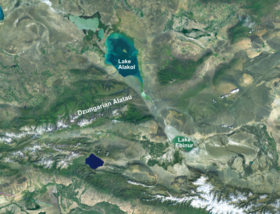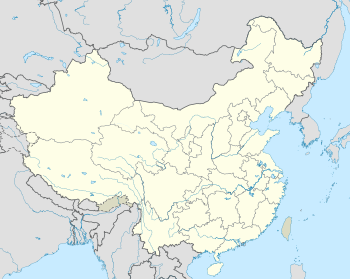Dzungarian Gate
| Dzungarian Gate | |
|---|---|
| Alataw Pass | |
 Satellite photograph of the Dzungarian Gate, the pale, fault-lined valley running between Lake Alakol and Lake Ebinur through the Dzungarian Alatau mountain range. | |
| Location | China–Kazakhstan border |
| Range | Dzungarian Alatau |
| Coordinates | 45°30′N 82°20′ECoordinates: 45°30′N 82°20′E |
| Dzungarian Gate | |||
| Chinese name | |||
|---|---|---|---|
| Traditional Chinese | 阿拉山口 | ||
| Simplified Chinese | 阿拉山口 | ||
| Literal meaning | Alataw Pass | ||
| |||
| Kazakh name | |||
| Kazakh | Жетісу қақпасы (Jetisw qaqpası) Жоңғар қақпасы (Joñğar qaqpası) | ||
The Dzungarian Gate is a geographically and historically significant mountain pass between China and Central Asia.[1] It has been described as the one and only gateway in the mountain-wall which stretches from Manchuria to Afghanistan, over a distance of three thousand miles."[2] Given its association with details in a story related by Herodotus, it has been linked to the location of legendary Hyperborea.[3]
The Dzungarian Gate (Chinese: 阿拉山口; pinyin: Ālā Shānkǒu; Kazakh: Жетісу қақпасы Jetisy' qaqpasy or Жоңғар қақпасы Jon'g'ar qaqpasy) is a straight valley which penetrates the Dzungarian Alatau mountain range along the border between Kazakhstan and the Xinjiang Uyghur Autonomous Region.[4] It currently serves as a railway corridor between China and the west. Historically, it has been noted as a convenient pass suitable for riders on horseback between the western Eurasian steppe and lands further east, and for its fierce and almost constant winds.[5]
In his Histories, Herodotus relates travelers' reports of a land in the northeast where griffins guard gold and where the North Wind issues from a mountain cave. Given the parallels between Herodotus' story and modern reports,[6][7] scholars such as Carl Ruck,[8] J.D.P. Bolton[9] and Ildikó Lehtinen[10] have speculated on a connection between the Dzungarian Gate and the home of Boreas, the North Wind of Greek mythology. With legend describing the people who live on the other side of this home of the North Wind as a peaceful, civilized people who eat grain and live by the sea, the Hyperboreans have been identified by some as the Chinese.[8][11]
Its gateway status is now supplanted by the new gateway city of Khorgas.
Contents
Geography
The windswept valley of the Dzungarian Gate, 6 mi (10 km) wide at its narrowest, is located between Lake Alakol to the northwest in Kazakhstan and Ebinur Lake (Chinese: 艾比湖; pinyin: Àibǐ Hú) to the southeast in China.[12] At its lowest, the floor of the valley lies at about 1,500 feet (450m) elevation, while the surrounding peaks of the Dzungarian Alatau range reach about 10,000 feet (3,000m) to the northeast and 15,000 feet (4,500m) to the southwest.[13]
Douglas Carruthers, who explored the area in the first decade of the 20th century, writes:
Geologically, the valley of Dzungarian Gate was created by the active strike-slip Dzungar fault system.[15] In strike-slip faults the blocks slide past each other laterally, and in this case they do so in a counter-clockwise direction or dextrally,[16] similar to the famous San Andreas Fault.
Remarking on it as a geological and physical phenomenon, Carruthers continues:
Noting that, "In prehistoric days the Dzungarian Gate must have presented a still more wonderful sight" when it "formed a narrow strait joining the Dzungarian inlet with the vast seas of Western Siberia,"[18] Carruthers quotes the British journalist and MP, Morgan Philips Price, with whom he travelled:[19]
History
Origins and the Silk Road
One of the earliest mentions of the Dzungaria region dates to when Emperor Wu of Han (reigning 156–87 BCE), dispatched the Han Chinese diplomat Zhang Qian to investigate lands to the west. The northernmost Silk Road trackway, about 2,600 kilometres (1,600 mi) in length, connected the ancient Chinese capital of Xi'an to the west over the Wushao Ling Pass to Wuwei and emerged in Kashgar before linking to ancient Parthia.[21]
Dzungaria is named after a Mongolian kingdom which existed in Central Asia during the seventeenth and eighteenth centuries. It derived its name from the Dzungars, who were so called because they formed the left wing (züün, left; gar, hand) of the Mongolian army, the self-named Oirats. It was raised to its greatest prominence by Kaldan (also known as Galdan Boshigtu Khan) in the latter half of the 17th century, who made repeated incursions on the territory of the Kazakh state, but was completely destroyed by the Qing government in about 1757–1759. It played an important part in the history of Mongolia and the great westward Mongolian migrations. After 1761 its territory fell mostly to the Qing dynasty (Xinjiang and north-western Mongolia) and partly to Russian Turkestan (earlier the Kazakh state provinces of Semirechye- Jetysu and Irtysh river).
A traveler going west from China must go either north of the Tian Shan through Dzungaria or south of the Tian Shan through the Tarim Basin. Trade usually took the southern route and migrations the northern. This is most likely because the Tarim leads to the Ferghana Valley and Iran, while Dzungaria leads only to the open steppe. The difficulty with the southern route was the high mountains between the Tarim and Ferghana. There is also another reason. The Taklamakan Desert of the Tarim is too dry to support much grass, and therefore lacked nomads likely to rob caravans. Its inhabitants lived mostly in oases formed where rivers ran out of the mountains into the desert. These were inhabited by peasants who were unwarlike and merchants who had an interest in keeping trade running smoothly. on the other hand, Dzungaria had a fair amount of grass, few towns to base soldiers in and no significant mountain barriers to the west. Therefore, trade went south and migrations north.[22]
Modern development
The Chinese city of Alashankou lies on the eastern end of the valley in the Börtala Mongol Autonomous Prefecture of Xinjiang. To the west, in the Almaty Province of Kazakhstan, lies its smaller counterpart, Dostyk, or Druzhba in Russian.
Modern development of the pass for its economic potential was delayed by political considerations. An agreement between the Soviet Union and the People's Republic of China to connect Kazakhstan with Western China by rail had been reached in 1954. on the Soviet side, the railway reached the border town of Druzhba (Dostyk) (whose names, both Russian and Kazakh, mean 'friendship') in 1959. on the Chinese side, however, the westward construction of the Lanzhou-Xinjiang railway was stopped once it reached Urumqi in 1962. Due to the Sino-Soviet Split, the border town remained a sleepy backwater for some 30 years, until the Alashankou railway station was finally completed on September 12, 1990.
Hyperborean connection
The Dzungarian Gate has been noted in modern history as the most convenient pass for horseback riders between the western Eurasian steppe and lands further east, and for its fierce and almost constant winds.[23] The area has also become known for its gold deposits and for producing prodigious numbers of dinosaur fossils, especially Protoceratops. Given that Herodotus relates a story of a traveller to the East who visited a land where griffins guard gold and east of which live the Hyperboreans, modern scholars have theorized that the Dzungarian Gate may be the real-world location of the home of Boreas, the North Wind of Greek Legend.[8][24]
The Greek writer Herodotus writes in his Histories (4.13) that the explorer Aristeas, a native of Proconnesus in Asia Minor active circa 7th century BC, had written a now lost hexameter poem about a journey to the Issedones of the far north. Aristeas reported that beyond them lived the one-eyed Arimaspians, further on were the gold-guarding griffins, and beyond these the Hyperboreans.
Based on Greek and Scythian sources, Herodotus describes the Issedones as living east of Scythia and north of the Massagetae, while the geographer Ptolemy (VI.16.7) appears to place the trading stations of Issedon Scythica and Issedon Serica in the Tarim Basin.[26] They may have been identical with the people described in Chinese sources as the Wusun.[27] According to E. D. Phillips, the Issedones are "placed by some in Western Siberia and by others in Chinese Turkestan."[28] J. D. P. Bolton places them on the south-western slopes of the Altai Mountains.[29]
Since Herodotus places the Hyperboreans beyond the Massagetae and Issedones, both Central Asian peoples, it appears that his Hyperboreans may have lived in Siberia. Heracles sought the golden-antlered hind of Artemis in Hyperborea. As the reindeer is the only deer species of which females bear antlers, this would suggest an arctic or subarctic region. Following Bolton's location of the Issedones on the south-western slopes of the Altay Mountains, Ruck places Hyperborea beyond the Dzungarian Gate into northern Xinjiang, noting that the Hyperboreans were probably Chinese.[8]
Griffin
The griffin (Greek: γρύφων, grýphōn), a legendary creature with the body of a lion and the head and wings of an eagle,[30] is a common heraldic theme of Central Asia.[31] According to modern theory, the griffin was an ancient misconception derived from fossilized remains of the Protoceratops found in conjunction with gold mining in the mountains of Scythia, present day eastern Kazakhstan.[32][33][34]
According to Mayor and Dodson the association of the Dzungarian Gate with gold and griffin (Protoceratops) skeletons spanned a thousand years of classical history:[35]
North Wind
The story of Boreas, the personified cold north winter wind of Greek legend who lived in a cave north of Greece, parallels that of the buran, a strong winter wind said to blow into the Kazakh steppe out of a hole in a mountainside in the Dzungarian Gate.[37][38]
Buran
Ildikó Lehtinen writes that "the story of the cave of the stormwinds somewhere near the Dzungarian Gate" has been known for 2500 years, by travelers from Aristeas in the classic era, to Giovanni di Piano Carpini in the Middle Ages (before Marco Polo), and to Gustaf John Ramstedt in the 20th Century.[39]
Carruthers reports the story of the buran, a ferocious winter wind said to sally from a hole in the side of a mountain:
Boreas
Boreas (Greek: Βορέας, Boréas) was the Greek god of the cold north wind and the bringer of winter. (Mallory and Adams speculate that the name may derive from a Proto-Indo-European root *gworh- meaning mountain.[41]) Boreas is depicted as being very strong, with a violent temper to match. He was frequently shown as a winged old man with shaggy hair and beard, holding a conch shell and wearing a billowing cloak.[1] Pausanias wrote that Boreas had snakes instead of feet, though in art he was usually depicted with winged human feet. Closely associated with horses (native to the Eurasian steppe; see Przewalski's Horse, also known as the Dzungarian Horse), Boreas was said to have fathered twelve colts after taking the form of a stallion, to the mares of Erichthonius, king of Troy. Pliny (Natural History iv.35 and viii.67) thought that mares might stand with their hindquarters to the North Wind, and bear foals without a stallion. Przwalski's mares are noted for turning their hindquarters to strong winds.[42] The Greeks believed that Boreas's home was in Thrace, and Herodotus and Pliny both describe a northern land known as Hyperborea ("Beyond the North Wind"), where people lived in complete happiness and had extraordinarily long lifespans.
See also
'호라즘·교탄·타림분지' 카테고리의 다른 글
| <펌> Samarkand (0) | 2019.02.10 |
|---|---|
| <펌> Kurgan (0) | 2019.02.06 |
| <펌> Tarim Mummies (0) | 2019.02.03 |
| <펌> 타클라마칸 사막 (0) | 2019.02.03 |
| <펌> Kindom of Khotan (0) | 2019.02.03 |









